
Houseplants have become cherished companions in many homes, providing aesthetic pleasure and contributing to indoor air quality. When moving to a new home, it’s essential to ensure that these green friends receive the special care they need during the transition. Understanding why houseplants require particular attention, identifying the best season for their move, and considering professional help are crucial steps for a successful plant relocation.
Why Houseplants Require Special Care During Moves
Houseplants are not just decorative items; they are living organisms that can experience stress from changes in their environment. Moving them can cause trauma that affects their health and growth. Several factors contribute to the need for special care during the move.
Firstly, the physical act of moving can damage the plants. Their delicate stems and leaves can be easily bruised or broken, and their root systems can be disturbed. Additionally, changes in temperature, light, and humidity during transit can shock the plants, potentially leading to wilting or even death. To mitigate these risks, many people turn to Calgary residential movers, who are experienced in handling such delicate tasks.
Secondly, houseplants have specific requirements that need to be maintained even during a move. This includes proper watering, the right amount of sunlight, and protection from extreme temperatures. Failure to meet these needs can result in significant stress for the plants, manifesting in yellowing leaves, stunted growth, or other signs of distress.
Ideal Seasons for Moving Houseplants
Choosing the right season to move houseplants can make a significant difference in their ability to adapt to a new environment. Each season has its pros and cons, and understanding these can help in planning a successful move.
Spring and early summer are generally considered the best times for moving houseplants. During these periods, plants are in their growth phase, which means they are more resilient and can recover faster from the stress of relocation. The moderate temperatures and longer daylight hours also provide an ideal environment for plants to acclimate to their new surroundings.
